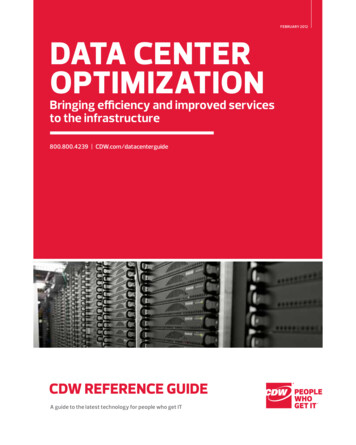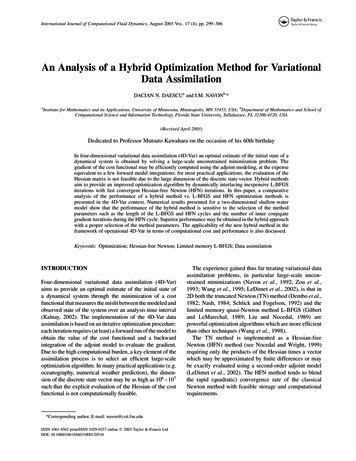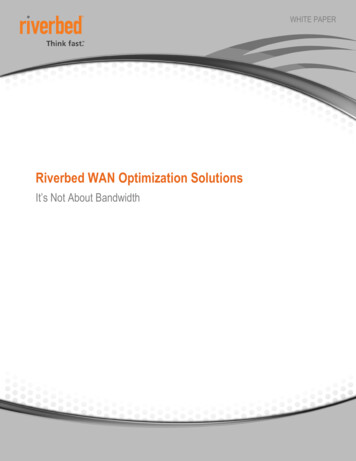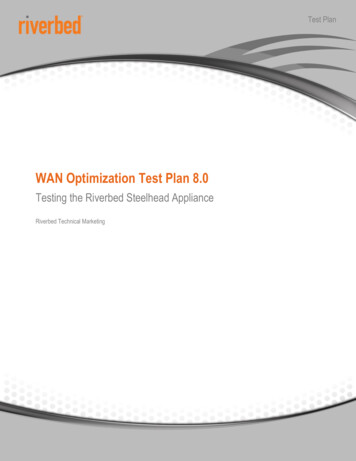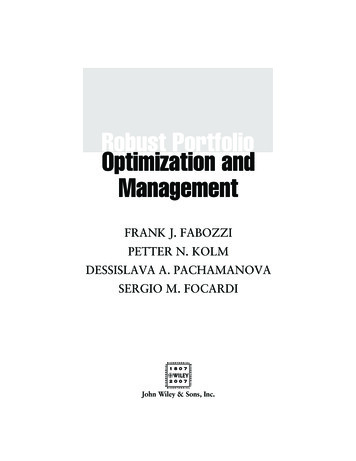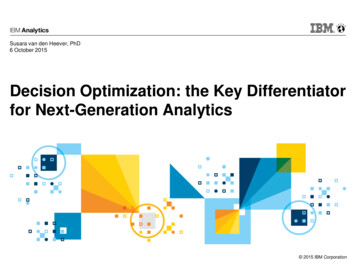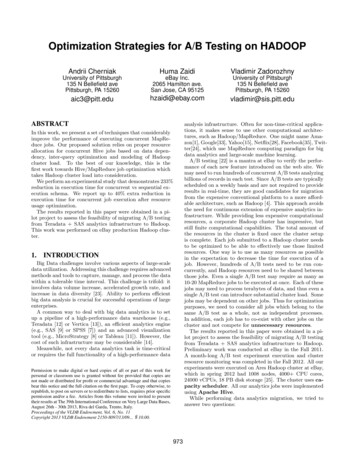
Transcription
Optimization Strategies for A/B Testing on HADOOPAndrii CherniakHuma ZaidiVladimir ZadorozhnyUniversity of Pittsburgh135 N Bellefield avePittsburgh, PA 15260eBay Inc.2065 Hamilton ave.San Jose, CA 95125University of Pittsburgh135 N Bellefield avePittsburgh, PA .eduABSTRACTanalysis infrastructure. Often for non-time-critical applications, it makes sense to use other computational architectures, such as Hadoop/MapReduce. One might name Amazon[1], Google[33], Yahoo[15], Netflix[28], Facebook[35], Twitter[24], which use MapReduce computing paradigm for bigdata analytics and large-scale machine learning.A/B testing [22] is a mantra at eBay to verify the performance of each new feature introduced on the web site. Wemay need to run hundreds of concurrent A/B tests analyzingbillions of records in each test. Since A/B tests are typicallyscheduled on a weekly basis and are not required to provideresults in real-time, they are good candidates for migrationfrom the expensive conventional platform to a more affordable architecture, such as Hadoop [4]. This approach avoidsthe need for continuous extension of expensive analytics infrastructure. While providing less expensive computationalresources, a corporate Hadoop cluster has impressive, butstill finite computational capabilities. The total amount ofthe resources in the cluster is fixed once the cluster setupis complete. Each job submitted to a Hadoop cluster needsto be optimized to be able to effectively use those limitedresources. One way is to use as many resources as possiblein the expectation to decrease the time for execution of ajob. However, hundreds of A/B tests need to be run concurrently, and Hadoop resources need to be shared betweenthose jobs. Even a single A/B test may require as many as10-20 MapReduce jobs to be executed at once. Each of thesejobs may need to process terabytes of data, and thus even asingle A/B test can introduce substantial cluster load. Somejobs may be dependent on other jobs. Thus for optimizationpurposes, we need to consider all jobs which belong to thesame A/B test as a whole, not as independent processes.In addition, each job has to co-exist with other jobs on thecluster and not compete for unnecessary resources.The results reported in this paper were obtained in a pilot project to assess the feasibility of migrating A/B testingfrom Teradata SAS analytics infrastructure to Hadoop.Preliminary work was conducted at eBay in the Fall 2011.A month-long A/B test experiment execution and clusterresource monitoring was completed in the Fall 2012. All ourexperiments were executed on Ares Hadoop cluster at eBay,which in spring 2012 had 1008 nodes, 4000 CPU cores,24000 vCPUs, 18 PB disk storage [25]. The cluster uses capacity scheduler. All our analytics jobs were implementedusing Apache Hive.While performing data analytics migration, we tried toanswer two questions:In this work, we present a set of techniques that considerablyimprove the performance of executing concurrent MapReduce jobs. Our proposed solution relies on proper resourceallocation for concurrent Hive jobs based on data dependency, inter-query optimization and modeling of Hadoopcluster load. To the best of our knowledge, this is thefirst work towards Hive/MapReduce job optimization whichtakes Hadoop cluster load into consideration.We perform an experimental study that demonstrates 233%reduction in execution time for concurrent vs sequential execution schema. We report up to 40% extra reduction inexecution time for concurrent job execution after resourceusage optimization.The results reported in this paper were obtained in a pilot project to assess the feasibility of migrating A/B testingfrom Teradata SAS analytics infrastructure to Hadoop.This work was performed on eBay production Hadoop cluster.1.INTRODUCTIONBig Data challenges involve various aspects of large-scaledata utilization. Addressing this challenge requires advancedmethods and tools to capture, manage, and process the datawithin a tolerable time interval. This challenge is trifold: itinvolves data volume increase, accelerated growth rate, andincrease in data diversity [23]. Ability to perform efficientbig data analysis is crucial for successful operations of largeenterprises.A common way to deal with big data analytics is to setup a pipeline of a high-performance data warehouse (e.g.,Teradata [12] or Vertica [13]), an efficient analytics engine(e.g., SAS [9] or SPSS [7]) and an advanced visualizationtool (e.g., MicroStrategy [8] or Tableau [11]). However, thecost of such infrastructure may be considerable [14].Meanwhile, not every data analytics task is time-criticalor requires the full functionality of a high-performance dataPermission to make digital or hard copies of all or part of this work forpersonal or classroom use is granted without fee provided that copies arenot made or distributed for profit or commercial advantage and that copiesbear this notice and the full citation on the first page. To copy otherwise, torepublish, to post on servers or to redistribute to lists, requires prior specificpermission and/or a fee. Articles from this volume were invited to presenttheir results at The 39th International Conference on Very Large Data Bases,August 26th - 30th 2013, Riva del Garda, Trento, Italy.Proceedings of the VLDB Endowment, Vol. 6, No. 11Copyright 2013 VLDB Endowment 2150-8097/13/09. 10.00.973
4x 10spillsmemorybuffermap 131mergedspills122map 2HDFS14othermappers2reduce 13inputsplitHDFStotal map slots4inputsplit0reduce 23000inputsplitjob map slots2500shufflemerge2000Figure 2: MapReduce execution schema1500100050001.471.481.491.51.51time, s1.521.53Apache Hadoop is a general-purpose framework for distributed processing of large data sets across clusters of computers using a simple programming model. It is designedto scale up from a single server to thousands of machines,each offering local computation and storage. Hadoop provides the tools for distributed data storage (HDFS: Hadoopdistributed file system [29]) and data processing (MapReduce). Each task submitted to a Hadoop cluster is executedin the form of a MapReduce job [16], as shown in Figure 2.JobTracker [4] is the service within Hadoop that farms outMapReduce tasks to specific nodes in the cluster. The JobTracker submits the work to the chosen TaskTracker nodes.TaskTracker is a node in the cluster that accepts tasks Map, Reduce and Shuffle operations - from a JobTracker. ATaskTracker is configured with a set of slots (map and reduce), which indicate the number of tasks that it can accept[41] at a time. It is up to the scheduler to distribute thoseresources between MapReduce jobs.There are several ways to write MapReduce jobs. Themost straight-forward one is to write a Java program using MapReduce API. While this method provides the highest data manipulation flexibility, it is the most difficult anderror-prone. Other tools, such as functional languages(Scala [10]), data processing workflow (Cascading [6]),and data analysis languages (Pig [3], Hive [35]) help tocover the underlying details of MapReduce programming,which can speed up development and eliminate typical errors. Apache Hive was chosen as a tool for these experiments because of its similarity with SQL, and to eliminatethe need for low-level programming of MapReduce jobs.1.545x 10Figure 1: A/B test execution monitoring. Top plot: mapslot usage in the entire cluster. Bottom plot: map slot usageby the A/B test jobs how to minimize the execution time of a typical A/Btest on Hadoop; how to optimize resource usage for each job thus ourA/B test can co-exist with other tasks;Consider an example Hive job, repetitively executed onHadoop, as shown in Figure 1. We monitored the amountof resources (here - the number of map slots) used by thejob together with total map slot usage in the entire Hadoopcluster. The upper plot shows how many map slots werein use in the entire Hadoop cluster during the experiment.The bottom plot shows how many map slots our sampleMapReduce job received during the execution. We observethat when the cluster is becoming busy, MapReduce jobshave difficulty accessing desired amount of resources. Thereare three major contributions we provided in this paper.1. we provide empirical evidence that each MapReducejob execution is impacted with the load on the Hadoopcluster, and this load has to be taken into considerationfor job optimization purposes2. based on our observations, we propose a probabilisticextension for MapReduce cost model2.13. we provide an algorithm for optimization of concurrent Hive/MapReduce jobs using this probabilistic costmodelOur paper is organized as follows. We start with providingsome background on performance of Teradata data warehouse infrastructure and Hadoop in Section 2. We continueby presenting updated MapReduce cost model in Section 3.Then finally we apply this cost model to optimize a real A/Btest running on a production Hadoop cluster and report theresults in Section 4.2.MapReduce data flowEvery MapReduce job takes a set of files on HDFS as itsinput and, by default, generates another set of files as theoutput. Hadoop framework divides the input to a MapReduce job into fixed-size pieces called splits. Hadoop createsone map task for each split [5]. Hadoop takes care of scheduling, monitoring and rescheduling MapReduce jobs. It willtry to execute map processes as close as possible [29] to thedata nodes, which hold the data blocks for the input files.We cannot explicitly control the number of map tasks [5].The actual number of map tasks will be proportional to thenumber of HDFS blocks of the input files. It is up to thescheduler to determine how many map and reduce slots areneeded for each job.BACKGROUNDDealing with big data analysis requires an understandingof the underlying information infrastructure. This is crucial for proper assessment of the performance of analyticalprocessing. In this section, we start with an overview ofHadoop, - a general-purpose framework for data-intensivedistributed applications. We also discuss the existing methods for data analytics optimization on Hadoop.2.1.1Capacity schedulerOur Hadoop cluster was configured to use capacity scheduler [2]. The whole cluster was divided into a set of queueswith their configured map and reduce slots capacities. Hardcapacity limits specify the minimum number of slots each974
queue will provide to the jobs. Soft limits specify how muchextra capacity this queue can take from the cluster providedso that the cluster resources are under-utilized. When thecluster gets fully loaded, those extra resources will be reclaimed for the appropriate queues. In Figure 1, we observe the effect of this reclamation: when the total load onthe cluster reached its maximum: MapReduce jobs in ourqueue were not able to obtain as many resources as they hadbefore. A similar effect happens when we submit yet anotherjob to a queue: each job from that queue will receive lessresources compared to what they had before.2.2[37] considers optimization of a group of independent concurrent MR jobs, using FIFO scheduler with no backgroundMR jobs running (from other users) on the cluster. We usecapacity scheduler instead of FIFO scheduler on our cluster,and we cannot explicitly control resources assignment foreach MR job. Typically A/B testing jobs show strong dependency between each other, and this dependence impactsthe performance.[42] presented a scheduler which tries to optimize multipleindependent MR jobs with given priorities. It functions byproviding requested amount of resources for jobs with higherpriority, and redistributes the remaining ”slack” resources tojobs with lower priorities. [42] provides batch optimizationfor a set of MR jobs where each job is assigned its priority.This is not true for our case: other users submit their jobswhenever they want and can take a significant portion of theavailable resources. Thus, the approach has to take on-lineload into consideration.Current approaches for Hadoop / MapReduce optimizationWe can group existing efforts in MapReduce jobs optimization into the following categories: scheduler efficiency,Hadoop and MapReduce (MR) system parameters optimization, and MR execution modeling.2.2.1Hadoop scheduler optimization2.2.2The default Hadoop scheduler is FIFO [41]. However,this may not be the best scheduler for certain tasks. Theexisting work in scheduling optimization addresses some ofthe most typical issues with execution optimization of MRjobs. One sample issue is resource sharing between MR jobs(Capacity scheduler [2], Fair Scheduler [45]), so one job doesnot suppress the execution of other jobs or does not occupytoo many of the resources. [27] provides a summary of someof the existing schedulers for Hadoop. Here we provide asummary of the existing approaches to improve schedulingfor Hadoop and how their optimization is applicable to ourtask of A/B testing.Resource-aware scheduler [44] suggests using fine-granularityscheduling through monitoring resources usage (CPU, disk,or network) by each MR job. Delay scheduling [46] is tryingto address the issue of data locality for MR job execution.Coupling Scheduler [31] approach is aimed at reducing theburstiness of MR jobs by gradually launching Reduce tasksas the data from the map part of a MR job becomes available. These schedulers treat each MR job as completelyindependent of one another, which is not true for our case.In addition, these schedulers say nothing about how to redistribute Hadoop resources between multiple concurrentMR jobs.[38] introduced the ”earliest-deadline-first” approach forscheduling MR jobs. The proposed approach (SLO-basedscheduler) provides sufficient resources to a process, thus, itcan be finished by the specified deadline. The authors report in the paper that when the cluster runs out of resources,then the scheduler cannot provide any guarantees regardlessof process execution time. This happens because SLO-basedscheduler is backed by FIFO scheduler [47]. Thus, first, westill need to perform off-line calculations about the optimal timing for each MR task. [38] says nothing about howto undertake this optimization, when there are many interdependent MR jobs, each of which is big enough to use allof the cluster resources available. Second, this approach isbased on FIFO scheduler, therefore it provides the capabilityto control resources for each process, but this is not available for capacity scheduler which is running on our Hadoopcluster. And third, this approach does not consider the background Hadoop load caused by other processes, which canbe launched at any arbitrary time.975Hadoop/MapReduce system parameter optimizationThere were several approaches to model Hadoop performance with different levels of granularity. For instance, [40]considers a detailed simulation of the Hadoop cluster functionality. It requires the definition of a large number ofsystem parameters; many of them may be not available toa data analyst. Similarly, [19] is based on quite detailedknowledge of the cluster set up. [21] and [20] approachesrelax the need for up-front knowledge of your cluster systemparameters and provide a visual approach to investigate bottlenecks in system performance and to tune the parameters.While these approaches address very important issues ofMR job and Hadoop cluster parameter tuning, they do notaddress a more subtle issue: concurrent job optimization fora cluster which is shared between many users, executing allsorts of MapReduce jobs. These approaches do not considerhow to adjust Hadoop/MR parameters so that many MRjobs can effectively co-exist.2.2.3MapReduce cost modelWhile MR job profiling [20] can help to optimize a singlejob, it is much more practical to have a simplified generative model which would establish the relationship betweenthe MR job execution time, the size of the input dataset andthe amount of resources which a MR job receives. Thus, wecan calibrate this model once by executing a few sampleMR jobs, measure their execution time, and use the obtained model for a quick approximate prediction of a MRjob completion time.[37], [36], [39], [43], [19], [40] attempt to derive an analytical cost model to approximate MR execution timing.Each of these approaches specifies an elementary cost modelfor data processing steps in MR and then combine elementary cost estimates in an overall performance assessment.It is interesting to mention, that different approaches havedifferences even with this simplified model. For instance,[39] and [37] do not account for sorting-associated costs andthe overhead required to launch map and reduce jobs as in[36]. These differences are associated with the fact that MRframework can launch in-memory or external sorting [41].And thus, cost models obtained for different sizes of thedata set will differ.
MThe Hadoop/MR framework has a substantial number oftuning parameters. Tuning some of those parameters mayhave a dramatic influence on the job performance, whiletuning others may have a less significant effect. Moreover,some of the tuning may have a non-deterministic impact, ifwe optimize the usage of a shared resource. For instance,assume that after the job profiling from [21] we decided toincrease the sort buffer size for a MR job. Let us do the samefor every MR job. If, after this buffer tuning, we launch toomany MR jobs at once, some nodes may run out of RAMand will start using the disk space for swapping to providethe requested buffer size. Thus, from time to time, insteadof speeding up, we will slow down concurrent job execution.This non-deterministic collective behavior has to be reflectedin the cost model.We based our cost model on the approaches proposed in[36] and [43], to reflect the deterministic characteristics ofMR execution. We extend those models by adding the probabilistic component of MR execution. In Section 3, weelaborate on the MapReduce cost model and describe howwe use it to estimate our Hadoop cluster t1(a) Completelyschedulesequentialt2(b) Interleaving schedulemapMAt11CBt21RreduceDt1t2(c) Concurrent schedule forindependent jobs(d) Concurrent schedule forjobs with dependenciesFigure 3: Examples of execution schedule for MapReducejobsMapReduce job execution. Map task execution may havelong tails where most of the tasks have been completed,however the whole job is waiting for the last few map tasks.This situation is a variation of resource starvation problem[32].Another possible improvement to the scheduling scenarioshown in Figure 3c, is when we submit all independentjobs simultaneously. This approach will maximize map andreduce slot usage. However, if some of the jobs are interdependent, this approach may lead to a very interesting problem.Consider an example scenario from Figure 3d. Here, taskD consumes the output from tasks B and C. Task A is completely independent of tasks B,C, and D. The optimizationin this scenario is difficult because it depends on all 4 tasksand how many resources provided by Hadoop. In a typicalsetup for an A/B test, each of those four tasks is bigenough that, on its own, it can occupy all map andreduce slots in the queue. If we apply the optimizationlogic from Figure 3c, then task A will consume a portion ofthe map and reduce slots, thus tasks B and C will take longerto finish their work and task D will start (and finish) later.If task A is relatively quick, then we would want to implement optimization from Figure 3b when task A launchesits map jobs after tasks B and C finished their map partand then execute the reducer jobs. If task A is relativelylong, then we would like to use a scheduling scenario fromFigure 3c when task A is launched together with B and C,but receives a lower priority and uses only spare map slotsand does not slow down B and C. There are many possiblescenarios in this 4-task problem, and the solu
lot project to assess the feasibility of migrating A/B testing from Teradata SAS analytics infrastructure to Hadoop. Preliminary work was conducted at eBay in the Fall 2011. A month-long A/B test experiment execution and cluster resource monitoring was completed in the Fall 2012. All our experiments were





